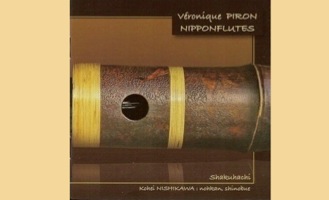
Véronique PIRON, shakuhachi, flûte
Musicien invité: Kohei NISHIKAWA*, shinobue, nohkan
Enregistré, mixé, masterisé par Pierre DANIEL,
studio SIAM, Rennes-Bretagne-France
(P) © 2010 Production, textes et design: Véronique PIRON
Réalisation-exécution: Gaels PETRIS
CD disponible ICI
En téléchargement sur Bandcamp
OTACHI-ZAKE, YACHIYO-JISHI*, TSURU no SUGOMORI, FINIS-TERRAE,
SHIKA no TÔNE*, SAN'AN, TRILLIUM, SANYA SUGAGAKI*, NAGAMOCHI-UTA
(extraits sur Soundcloud)
![]()
. . . . . . . . . . . . . . . . . . . . . . . . . . . . . . . .
Le programme de cet enregistrement de flûtes en bambou du Japon est construit autour de pièces de styles et d’époques différentes appartenant principalement au répertoire du shakuhachi: solos de shakuhachi, trois duos que nous avons adaptés et réarrangés pour ces différentes flûtes en bambou, des pièces de tradition classique (honkyoku, jiuta/nagauta) ou populaire (minyô) dont quelques grands standards du répertoire, une pièce contemporaine pour flûte, Trillium, inspirée du langage du shakuhachi, de la compositrice américaine Elisabeth BROWN rencontrée à Sydney en 2008 pendant le Festival International du Shakuhachi, et une composition originale que j'ai écrite pour le shakuhachi inspirée de mes racines bretonnes et celtiques, Finis-Terrae. Le livret s'ouvre sur un poème d'introduction sur le thème du bambou généreusement traduit du japonais par Gunnar Jinmei LINDER.
Cet album a été enregistré, mixé et masterisé par Pierre Daniel, qui emballé par l'aventure, a superbement capté l’esprit du son et du souffle de cette musique, et en a fidèlement restitué toute la matière vivante. L’enregistrement a eu lieu dans un studio implanté à la campagne en dehors de la ville. Très inhabituel pour le flûtiste japonais Kohei Nishikawa, il a écrit ses impressions dans la chronique qu’il rédige régulièrement pour la revue japonaise “the flute” (en japonais): nishi furansu no studio
. . . . . . . . . . . . . . . . . . . . . . . . . . . . . . . .
Critique du CD par Adrian Bain, publiée dans la Newsletter de la Fédération Européenne du Shakuhachi (ESS) en 2010
This CD comprises pieces from different styles and periods from the shakuhachi repertoire and includes three duets adapted and arranged by Véronique Piron and Nishikawa Kohei, the eminent Japanese flautist.
1. Otachi Zake This minyo piece, played on a short shakuhachi in E, is calming and unrushed.
2. Yachiyo Jishi A duet, with the short shakuhachi in E making another appearance, this time blending nicely with nohkan and shinobue, with interesting melodies reflecting$ the Kabuki feeling of the piece. The mix of flutes do not compete, each claiming its own space, but not obstructing the other.
3. Tsuru no Sugomori Véronique’s handling of the standard shakuhachi in D is splendid. This version is from Sendai in the North-East of Japan and uniquely has an improvised middle section.
4. Finis-Terrae A new and pleasing composition by Véronique Piron with Breton Celtic roots.
5. Shika no Tone An interesting interpretation of one of the most striking pieces in the shakuhachi repertoire, played with the standard shakuhachi in D, nohkan and shinobue. The different natural pitches of the three flutes provides for a wide, complementary soundscape.
6. San’An Played on a long shakuhachi in B, San’An benefits from the excellent recording skills of Pierre Daniel, capturing important nuances in Véronique’s playing.
7. Trillium A composition for transverse flutes by the composer and performer Elizabeth Brown. This modern piece is fascinating and has some great, dextrous runs, engaging the attention throughout.
8. San’Ya Sugagaki A duet with standard shakuhachi and long shinobue, with the long shinobue leaving and returning throughout the piece, stitching the piece together in an interesting way.
9. Nagamochi Uta A minyo wedding celebratory piece, played on a long shakuhachi in B, emulates the human voice with repeated finger strikes.
The overall impressions received from Véronique Piron’s recording are unrushed and confident. I liked the quality of the recording. Pierre Daniel has captured a full, quite unadulterated sound, which is not too heavy on the reverb as some shakuhachi recordings can be. A lot of work has gone into this CD, by the players, the compositions and arrangements, the recording skills and the cover/booklet. Worthwhile work, producing an excellent CD.
Adrian Bain (originally published in the ESS Newsletter, Issue 17, 2010)